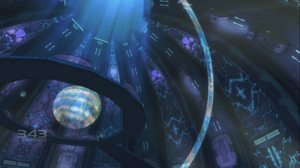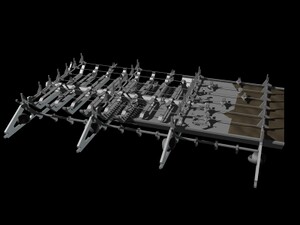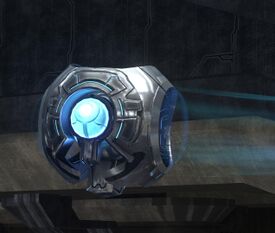Halo Array: Difference between revisions
From Halopedia, the Halo wiki
No edit summary |
Bbqsniper47 (talk | contribs) m (→Trivia) |
||
| Line 115: | Line 115: | ||
*The Halos are remarkably similar to the eponymous megastructure of [[Wikipedia:Larry Niven|Larry Niven's]] ''[[Wikipedia:Ringworld|Ringworld]]'' series. However, Niven's ringworld encircles a large star, whereas the Halos merely orbit planets, being much smaller than the former. The Halos are also very similar to the [[Wikipedia:Orbital (The Culture)|Orbitals]] from [[Wikipedia:Iain M. Banks|Iain M. Banks']] ''Culture'' series, though considerably smaller. | *The Halos are remarkably similar to the eponymous megastructure of [[Wikipedia:Larry Niven|Larry Niven's]] ''[[Wikipedia:Ringworld|Ringworld]]'' series. However, Niven's ringworld encircles a large star, whereas the Halos merely orbit planets, being much smaller than the former. The Halos are also very similar to the [[Wikipedia:Orbital (The Culture)|Orbitals]] from [[Wikipedia:Iain M. Banks|Iain M. Banks']] ''Culture'' series, though considerably smaller. | ||
*The names of the Halo installations are Beta, Epsilon, Kappa, Alpha, Delta, Gamma and Zeta Halo, ordered from 01 to 07 respectively. | *The names of the Halo installations are Beta, Epsilon, Kappa, Alpha, Delta, Gamma and Zeta Halo, ordered from 01 to 07 respectively. | ||
*The Halo textures for both ''Halo: Combat Evolved'' and ''Halo 2'' are the same, and are both symmetrical. | *The Halo textures for both ''[[Halo: Combat Evolved]]'' and ''[[Halo 2]]'' are the same, and are both symmetrical. | ||
*In a ''Halo: Combat Evolved'' [[Pre-Xbox Halo|prototype]], Installation 04 had a section that was only partially constructed. This feature was dropped from the final game, though it may have inspired the second Installation 04. | *In a ''Halo: Combat Evolved'' [[Pre-Xbox Halo|prototype]], Installation 04 had a section that was only partially constructed. This feature was dropped from the final game, though it may have inspired the second Installation 04. | ||
*On the screen where Captain Keyes taps his pipe on the opening scene of the ''Pillar of Autumn'', '''TRAJECTORY FD: HALO''' is displayed by the hologram of Installation 04, although the UNSC was not aware of the name at the time. | *On the screen where Captain Keyes taps his pipe on the opening scene of the ''Pillar of Autumn'', '''TRAJECTORY FD: HALO''' is displayed by the hologram of Installation 04, although the UNSC was not aware of the name at the time. | ||
Revision as of 23:59, April 21, 2012
| This article does not meet the wiki's general standards and/or standards on layouts. You can help by cleaning this article. |

- "Halo doesn't kill Flood, it kills their food! Humans, Covenant, whatever - we're all equally edible! The only way to stop the Flood is to starve them to death. And that's exactly what Halo is designed to do: wipe the galaxy clean of all sentient life!"
- — Cortana
The Halo Array, individually known as Halos or Halo Rings,[1] or alternatively known as the Sacred Rings[2][3] by the Covenant, Fortress Worlds[4] by their Forerunner creators, and Installations by the Monitors that run them, is a system of colossal ring-world superweapons.
The Halos were constructed by order of the Master Builder circa 101,000 BCE with the intent of being an ultimate weapon.[5] Eventually, five were lost and the remaining seven were used by the Forerunners as a last resort when combating the parasitic Flood. When nothing else could be done, they activated the rings, killing all sentient life forms within three radii of the galactic center.
In addition to serving as weapons of last resort, Halo installations are also research facilities dedicated to containing and studying the Flood.
Background
The Halo Array is a network of seven (originally twelve) ring-shaped megastructures created by the Forerunners, designed to exterminate all sentient life within the Milky Way galaxy.[6] Built following the human-Forerunner wars, these ringworlds were used as a last resort against the Flood, a parasitic extra-galactic species that threatened to infest every sentient life-form in the galaxy. By activating the rings, the Forerunners denied the Flood access to these life-forms, effectively starving the species to virtual extinction, though specimens were kept in a number of Forerunner containment facilities, including the Halo installations themselves.[7]
Twelve Halo rings existed during the reign of the Forerunners. Of these, only seven survived to be included in the final Array. The two most well-known Halo installations, Installation 04 and Installation 05, both orbit gas giants, though it is not known whether this is the case of all the Halos. Installation 04 maintained an atmospheric mining facility in Threshold's atmosphere until it was destroyed by the Covenant.[8] Though separated by thousands of light-years, the installations are networked together and capable of remote activation at the Ark, an extragalatic fallback point. Each Halo installation has a maximum effective range of 25,000 light-years.[9][10] The method utilized by the array to conduct this "mass sterilization protocol"[11] involves the superluminal conveyance of a burst of cross-phased super-massive neutrinos tuned to emit a harmonic frequency that destroys the nervous system of any life form within range. Simpler organisms lacking a neural system are unaffected, along with inanimate structures. Precursor technology, however, is extremely susceptible to damage from the Halo effect.[12][5]
The Halo Array in its entirety has only been fired once in known history, approximately 100,000 years ago, by the Didact[13] in order to stop the Flood from overwhelming the galaxy. Despite being the network's builders, the Forerunners were - as far as is known - killed in this last suicidal attempt to save the rest of the universe from a worse fate.[6] The array has nearly been activated three times since; Installation 04 was almost activated by the Master Chief before being deactivated by Cortana, while Installation 05 was activated by Commander Miranda Keyes, forced by the Chieftain of the Jiralhanae Tartarus, and Sergeant Johnson was forced by the Prophet of Truth to activate the Ark. None of these attempts were successful. A replacement Halo for the destroyed Installation 04 was activated outside of the array's range, eliminating the freed Flood, but did not activate the rest of the Array, as it was still under construction at the time of its firing.[14]
Each of the Halo installations in the final Array is given a designation number, from 01 to 07, and is overseen by a monitor. The monitors are given control of the Installations' Sentinel automatons, from Aggressors to Constructors and Enforcers, and are responsible for containing the Flood test subjects in their research facilities and protecting the Halo from intruders.
The Array also encompasses Installation 00, an extragalactic construction facility that can create replacement Installations in the event that one is destroyed. All Installations can also be remotely activated from the Ark, as the megastructure is out of the Array's range.[15] The Forerunners also built shield worlds as a means to escape the effect without having to leave the galaxy.[16]
History
Construction
The Halos were constructed by Forerunner Builders several thousand years after early humanity first encountered and drove the Flood from the Milky Way. The most extreme faction of Builders, which at the time controlled the Ecumene Council, claimed that more extreme measures should be used to protect the galaxy against a possible Flood resurgence and proposed building the Array for this purpose. Although they faced strong opposition from the Prometheans, including the Didact, for thousands of years, the faction eventually won the approval of the Council and commenced work on the Array.[5]
Twelve Halos, each 30,000 kilometers in diameter, were originally commissioned by Master Builder Faber, but only one of them ultimately survived to be used in the Forerunners' final plan. A separate array of six smaller installations (each 10,000 kilometers in diameter) was also constructed and remained under the Librarian's control at Installation 00.[17]
Forerunner-Flood war
The first test of a Halo installation was conducted by 05-032 Mendicant Bias, who fired Installation 07 in the system of Charum Hakkor and Faun Hakkor on a low power setting, destroying all of the sentient life on the latter planet and inadvertantly releasing a Precursor from captivity on the former planet. Mendicant Bias then brought the released Precursor to the Halo for study and took said Halo with him as per his mission to assault the Gravemind, but both he and the ring vanished and were not seen for another 43 years.
The other eleven Halo installations were taken to the Forerunner capital during the tribunal against Master Builder Faber, where it was to be decided whether to decommission them following the use of one of the weapons by Faber to suppress a rebellion on the San 'Shyuum homeworld of Janjur Qom. However, in the midst of the trial, Mendicant Bias, turned rampant by the Gravemind, appeared with the twelfth Halo and assaulted the capital. He attempted to seize control of the remaining Halos and fire them, but was only able to control five out of the twelve. One of those five was destroyed by the combined tidal forces of the capital, the firepower of local Forerunner fleets, and the stress of a recent slipspace transition. The seven Halos that Mendicant Bias was unable to control were recalled to Installation 00 via slipspace jumps, yet only one escaped before the portal collapsed.
Installation 07, the Halo where Mendicant Bias' core personality was housed at the time, jumped into a distant system on a pre-designated destructive collision course with a planet - a security measure put in place in case it fell under control of the Flood. The installation was eventually reclaimed by the Didact's forces and it survived the passage of the planet despite taking heavy damage. A significant amount of the ring's superstructure was discarded, reducing its size to 10,000 kilometers, in order to allow it to perform a successful slipspace jump to the greater Ark.
Later, as Mendicant Bias prepared his final assault on the Maginot Sphere, the Didact finally accepted that the Halo Array was the only solution to counter the Flood, and activated the Array. The effect left all Flood-controlled ships adrift, allowing Offensive Bias to defeat and capture the rampant AI.
Post-activation
The seven Halos then remained relatively dormant for approximately one hundred thousand years, though at least one of them experienced a major Flood outbreak, and at least one have experienced brief visits by other species, including a major crash-landing in 40,000 BCE.[18]
The Array's activation caused catastrophic damage to ecosystems across the galaxy, with innumerable species both sentient and non-sentient instantly rendered extinct. This uniform disruption manifested as the Ross-Ziegler Blip, which was dismissed as an anomaly caused by spatial distortion until humanity discovered the Array in 2552. Several species indexed by the Library Project did not survive reintroduction to their homeworlds, and those that did were all reverted to a Tier 7 technological state.
The Covenant Empire, a theocratic multispecies alliance, was founded on the misguided belief that the Halo Array was actually the source of a "Divine Wind" that allowed the Forerunners to transcend the physical. By activating the Array, they too could embark on this "Great Journey" and join the Forerunners in godhood.
Rediscovery
Eventually, the stellar coordinates of Installation 04 was discovered through the combination of a crystal artifact on Sigma Octanus IV and a huge Forerunner artifact buried under the surface of Reach. The coordinates were utilized by the UNSC Pillar of Autumn's shipboard AI Cortana to escape from the Fall of Reach. The cruiser arrived over the Installation's orbit and was subsequently shot down by Covenant ships. Most of the ship's combat personnel escaped and made landfall on the artificial construct, triggering the Battle of Installation 04.
During their investigations on Installation 04, the Covenant encountered a Flood containment facility and unknowingly released the dormant Flood; they quickly, but only partially, reestablished containment. Soon, a squad of Marines led by Captain Jacob Keyes accidentally broke quarantine again, expecting to find a large Covenant weapons cache. The human-waged guerilla war quickly turned into a massive four-way battle between UNSC forces, the Covenant, Sentinels led by 343 Guilty Spark, and the Flood.
The battle finally culminated when SPARTAN John-117 detonated the fusion engines of the Pillar of Autumn on the surface of the Installation, which compromised the structural integrity of the ring. The gravitational momentum and inertia still perpetuating the ring in orbit around Threshold then tore the ring apart. The remains of Installation 04 were scattered as debris in space. The explosion sent massive chunks of the ring careening into Basis; the moon suffered a constant bombardment of debris from the ring after its destruction.[19]
Later, the Covenant discovered a second Halo, Installation 05. On this Halo, the Flood had already been released and much of the ring had been compromised, including its monitor, 2401 Penitent Tangent. Soon, another four-way conflict began. The battle ended in the Flood manifesting a Gravemind and successfully escaping the ring aboard infected Covenant ships. The ring was nearly activated by Tartarus, the Chieftain of the Jiralhanae, but Commander Miranda Keyes pulled the Activation Index out of the installation's core at the last moment, causing all six functional installations to go into "standby mode", ready for remote activation from the Ark.
The human survivors returned to Earth and resumed their fight against the Covenant, who had uncovered a large structure on Earth, which they assumed to be the Ark. The Covenant landed the Forerunner Dreadnought in the center of the structure, activating it. However, the structure was soon revealed not to be the Ark, but a generator of a portal to the actual Ark, a massive artificial world located outside the galaxy. Human and Covenant separatist forces proceeded through the portal to the newly-discovered installation to prevent the Covenant from activating the remaining Halo rings remotely. Eventually, the Gravemind arrived at the Ark aboard High Charity, the Covenant's capital city, which had been turned into a Flood hive. The hive crashed onto the Installation, releasing the Flood.
Soon, 343 Guilty Spark, John-117, and Arbiter Thel 'Vadam discovered that the Ark had been constructing a new Installation 04, to replace the one which had previously been destroyed. This new installation was only days from being completed. The humans decided to activate the new ring to stop the Flood, resulting in the incomplete ring destroying itself, along with the Ark.[20]
By January 2553, the UNSC had begun an active search for the remaining Halo Installations.[21] By March 2553, the Office of Naval Intelligence had successfully located at least one, Installation 03, and constructed a research station, Ivanoff, in its orbit.[22]
Features
Custodial
The Installations are designed to be run by advanced artificial intelligence constructs specially purposed by the Forerunners. The highest intelligence on each Installation is a single Monitor.[23] The Monitor's task is to ensure that the installation's Constructors, Sentinels, and Enforcers repair, maintain, and defend the ring from damage, contain Flood specimens, and ensure that their own installation is ready to fire on demand, including running activation simulations.[3] Monitors also have access to their respective installation's defensive system. [24]
In addition, each installation contains less intelligent constructs, known as Sentinels. The Sentinels serve virtually any purpose necessary to ensure that the Halo functions properly and are capable of combating small Flood outbreaks. Should a major Flood outbreak occur, heavier automatons, such as the Enforcers and Sentinel Majors will be created to assist the Sentinels. In the meantime, Constructors are also created to ensure that the Forerunner structures on the Installation are kept in optimal shape, and that they are not damaged by conflict or weather.[25]
Save for the Monitor, all automatons can be constructed at specialized production facilities that float high in the Halo's atmosphere. They seem to contain almost limitless materials for constructing an almost indefinite number of automatons.
Environment
After Master Builder Faber's plans were co-opted by the Librarian, the Halos were given terrestrial surfaces to support catalogued specimens. The Master Builder intended to allow these specimens to be infected by Flood forms contained on the rings and subsequently terminated in order to test the Halos' effectiveness.[26] The Halo installations support a wide range of environments, habitats, ecosystems, and climates. Installation 04 and Installation 05 supported warm, temperate forests[27] that were both deciduous and coniferous, swamps, and cold, snow covered tundra environments.[28][29] Installation 00 had climate ranging all the way from tundra,[30] to forest,[30] to desert.[31] It is unknown whether this range is shared by all the Halos, but the similarity of these environments and that of Installation 00 makes it likely.
While the terrain may appear to be naturally formed at first glance, it is actually artificially constructed. Strato-Sentinels extract raw materials from the source, process them in transit, and deposit building materials at the Installation.[32] Four huge terraforming factories then move across the face of the installation to "skin" it with landmasses and bodies of water. These factories also hold in the ring's nitrogen-oxygen atmosphere, which is then leaked out to the surface, eventually pouring through the super-structure, and tugged in place by centripetal force.[33] The installation's buildings are then built by Constructors and Sentinels. An intricate layer of metallic panels is laid down several meters below the surface of the terrain, upon which rock, soil, and eventually vegetation is added. Slopes, hills and mountains can be created by sculpting these panels.[14] Some features, such as landslides, are the result of time, and have been formed naturally. Others, such as the myriad network of tunnels and cave systems that riddle the installation's internal structure, are travel conduits used by the ring's Sentinels and Enforcers. There are also some indigenous life-forms that live on the Halos; it is likely that the Forerunners brought these lifeforms to the installations.
Technology

Each Halo has several assets that are uniform to all installations. Each contains a Control Room located somewhere upon its inner surface, from which a Reclaimer must manually insert the installation's Activation Index to activate it. Each also possesses a Library, a large structure protected by an energy shield, where the Index is housed and protected by Sentinels.[7][34] The index itself is a semi-solid holographic representation of the data needed to activate the ring, and can only be directly inserted successfully by a Reclaimer.
Installations also possess Cartographer facilities, which contain holographic representations of the installation's inner passages and networks, to be used as a navigational reference for traversing the installation. Flood containment facilities are also standard, used by the installation's monitor to conduct research on and observe the surviving Flood specimens; these are protected by Sentinels to prevent an outbreak.[35]
Installations also contain advanced teleportation grids, allowing instantaneous transportation for a Monitor or Reclaimer to any place on the installation. These grids cannot be controlled by the Flood, though the Gravemind was able to use that of Installation 05 by controlling 2401 Penitent Tangent.[3] For Sentinels, the installation is riddled with tunnel and cave networks for access and transportation.[35] The Sentinel portals are connected to factories via tunnels.
The Halo rings achieve their "gravity" through centripetal force. As the ring spins, centripetal force pushes all spinning bodies away from the center of rotation. The ring is uniform, and because of this, all points are the same distance from the center, therefore centripetal force applies evenly. This force also pushes objects on the surface of the ring away from the center of rotation, or pushes them down on the surface of the ring, translating into gravity. When the UNSC Pillar of Autumn was detonated, it blasted a large mass from Installation 04; no longer a full loop, the centripetal force applied in much greater strength on the newly formed weak point, causing the ring to rip apart.
The Halo installations are also equipped with drive engines spaced along their rim. In the event of an emergency, a Halo can maneuver itself to avoid damage from a collision or weaponry.[36] In addition, they possess hard light reinforcement to stabilize and protect them against tidal and gravitational forces from other objects.[37]
The rings of the second Halo Array are 10,000 km in diameter; this size is roughly similar to that of Earth, which is 12,756 km in diameter. The surface of each ring is 318 kilometers wide.[38] The original twelve Halo rings were 30,000 km in diameter.[39] During the Battle of the capital, one of the original rings escaped to Installation 00, where it joined the six newly constructed installations.[40] Thus, one of the modern Halos is 30,000 km in diameter, unless another new installation was constructed to replace it. Each installation orbits a large, dense planet which serves as a gravitational anchor.[citation needed] For example, Installation 04 and Installation 05 orbited Threshold and Substance, respectively, which are both large gas giants.
Firing method
When activated, the Halo rings wipe out all sentient life within three radii of the Milky Way's center by sending a burst of cross-phased supermassive neutrinos.[41] This burst of neutrinos is carefully tuned to possess a harmonic frequency, which destroys the nervous system of any macroscopic organism that possesses one, even one as rudimentary as a notochord, as shown in the aftermath of a low-powered test firing of a Halo performed by Mendicant Bias in the system of Charum Hakkor.[42]
This pulse is propelled across the Halo Array's full radius at superluminal speeds,[43] covering that area and cleansing it of all affected life, though simpler life forms that do not possess a neural system, such as microbes, fungi, algae, mosses, and traditional plants are unaffected.[44]
21st century paleo-archeological studies gave no indication of the mass extinction caused by the Array's firing. However, in 2332 the Ross-Ziegler Blip revealed a tiny aberration in Earth's fossil records.[45]
Function
The Halo Array is complex, but each ring can be activated individually by a Reclaimer, also activating the other installations, or they can all be activated simultaneously from Installation 00. In the event of a major Flood outbreak, an installation's Monitor will seek out a Reclaimer if available, whom they will enlist to aid them. It will teleport them to the installation's Library and will assist the individual in retrieving the Index. The Monitor then stores the Index within its data arrays for safe transportation, lest the Reclaimer fall prey to the Flood before they can activate the installation. Once at the control room, the Reclaimer is given back the Index and must insert it into the control panel in order to begin the activation sequence.
The main weapon is amplified by phase pulse generators, three of which are close to the control room, at least on Installation 04. Each installation has a maximum effective radius of 25,000 light-years[10] and functions via form of lethal radiation.[46] The pulse is designed to kill all sentient life in the installation's three-dimensional radius, with the array covering the entire galaxy. The pulse targets the nervous system of sentient life forms via the issuing of a harmonic frequency.[47] The only known way to avoid the effects of these pulses is to seek shelter in a shield world or to escape to Installation 00, which is out of range of the array. Once activated from Installation 00, the other installations will fire simultaneously, eradicating all sentient life in the galaxy, thus starving and killing the Flood.[6]
Trivia
- The Halos are remarkably similar to the eponymous megastructure of Larry Niven's Ringworld series. However, Niven's ringworld encircles a large star, whereas the Halos merely orbit planets, being much smaller than the former. The Halos are also very similar to the Orbitals from Iain M. Banks' Culture series, though considerably smaller.
- The names of the Halo installations are Beta, Epsilon, Kappa, Alpha, Delta, Gamma and Zeta Halo, ordered from 01 to 07 respectively.
- The Halo textures for both Halo: Combat Evolved and Halo 2 are the same, and are both symmetrical.
- In a Halo: Combat Evolved prototype, Installation 04 had a section that was only partially constructed. This feature was dropped from the final game, though it may have inspired the second Installation 04.
- On the screen where Captain Keyes taps his pipe on the opening scene of the Pillar of Autumn, TRAJECTORY FD: HALO is displayed by the hologram of Installation 04, although the UNSC was not aware of the name at the time.
- In 2011, the Halo Array was the number 1 most "Ridiculously Oversized Videogame Weapon" by PasteMagazine.com.[48]
Gallery
- POAEngineRoom.jpg
Sentinels fighting the Flood on Installation 04.
List of appearances
|
|
Sources
- ^ Halo: Combat Evolved, level The Truth and Reconciliation
- ^ Halo: The Flood, page 38
- ^ a b c Halo 2, level Gravemind
- ^ Halo: The Flood, page 193
- ^ a b c Halo: Cryptum, page 274
- ^ a b c Halo 2, level The Great Journey, 343 Guilty Spark: "After exhausting every other strategic option, my creators activated the rings. They, and all additional sentient life in three radii of the galactic center, died, as planned."
- ^ a b Halo: Combat Evolved, level The Library
- ^ Halo 2, level The Oracle
- ^ Halo: Combat Evolved Anniversary, Terminal 8 ("25,000 light years. That is the effective range of this installation.")
- ^ a b Halo: Combat Evolved, level Two Betrayals, 343 Guilty Spark: "Technically, this installation's pulse has a maximum effective radius of twenty-five thousand light years."
- ^ Halo: Combat Evolved, level The Library, 343 Guilty Spark: "Why the Flood is, naturally, simply too dangerous to release, and mass sterilization protocols may again need to be enacted."
- ^ Halo: Cryptum, page 132
- ^ Iris, Array Recorder Data
- ^ a b Halo 3, campaign level Halo
- ^ Halo 3, level The Covenant, 343 Guilty Spark: "The Ark is out of range of all the active installations!"
- ^ Halo: Ghosts of Onyx, page ??
- ^ Halo: Cryptum, page 329
- ^ "Conversations from the Universe"
- ^ Halo 2, multiplayer level Burial Mounds
- ^ Halo: The Essential Visual Guide, page 14
- ^ Halo: Glasslands, page 50
- ^ Halo: Glasslands, page 428
- ^ Halo: Combat Evolved, level 343 Guilty Spark
- ^ Halo: Combat Evolved Anniversary, Terminal 1
- ^ Halo 2, level Sacred Icon
- ^ Halo: Cryptum, pages 313, 334
- ^ Halo 2, level Uprising
- ^ Halo: Combat Evolved, level Assault on the Control Room
- ^ Halo 2, level Quarantine Zone
- ^ a b Halo 3, level The Covenant
- ^ Halo 3, level The Ark
- ^ The Art of Halo 3, page 30
- ^ The Art of Halo 3, page 116
- ^ Halo 2, level Sacred Icon
- ^ a b Halo: The Flood, pages 240-242
- ^ Halo: Cryptum,, page 314
- ^ Halo: Cryptum, page 311
- ^ Halo: The Essential Visual Guide, page 6
- ^ Halo: Cryptum, page 310
- ^ Halo: Cryptum, page 335
- ^ Halo: Cryptum, page 274
- ^ Halo: Cryptum, pages 131-133
- ^ Halo: Legends,"Halo: The Story So Far" featurette, minutes 17:40-17:51
- ^ Halo: Cryptum, page 131
- ^ Halo: Evolutions - Essential Tales of the Halo Universe, From the Office of Dr. William Arthur Iqbal, page 519
- ^ Halo: Ghosts of Onyx, page 183
- ^ Halo Encyclopedia, pages 170-174
- ^ 9 Ridiculously Oversized Videogame Weapons








